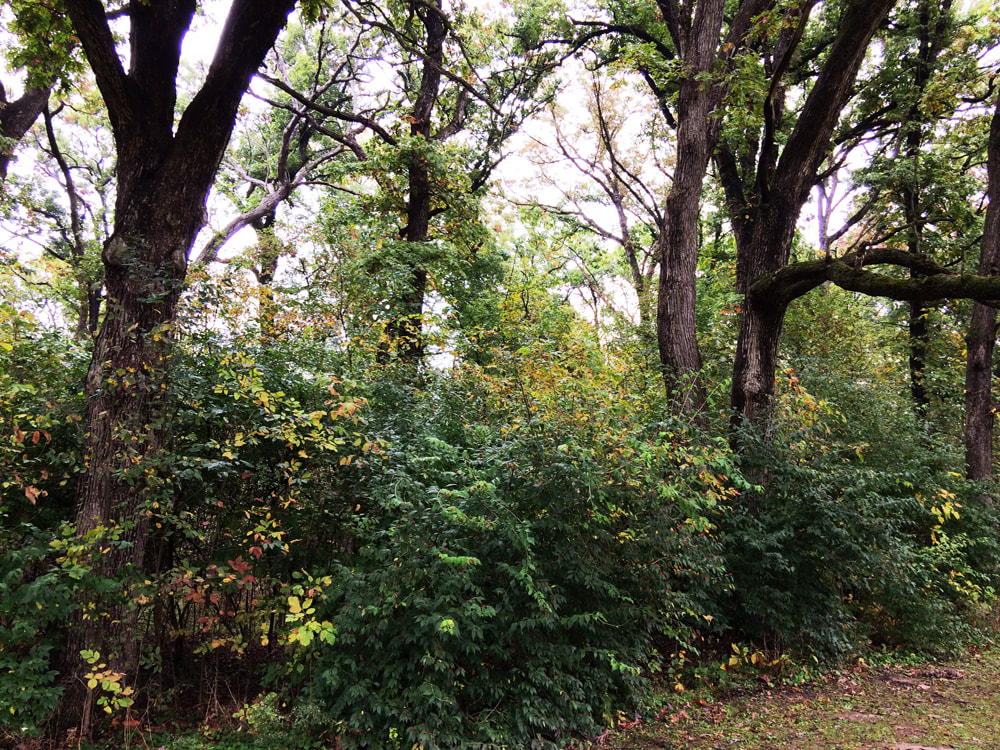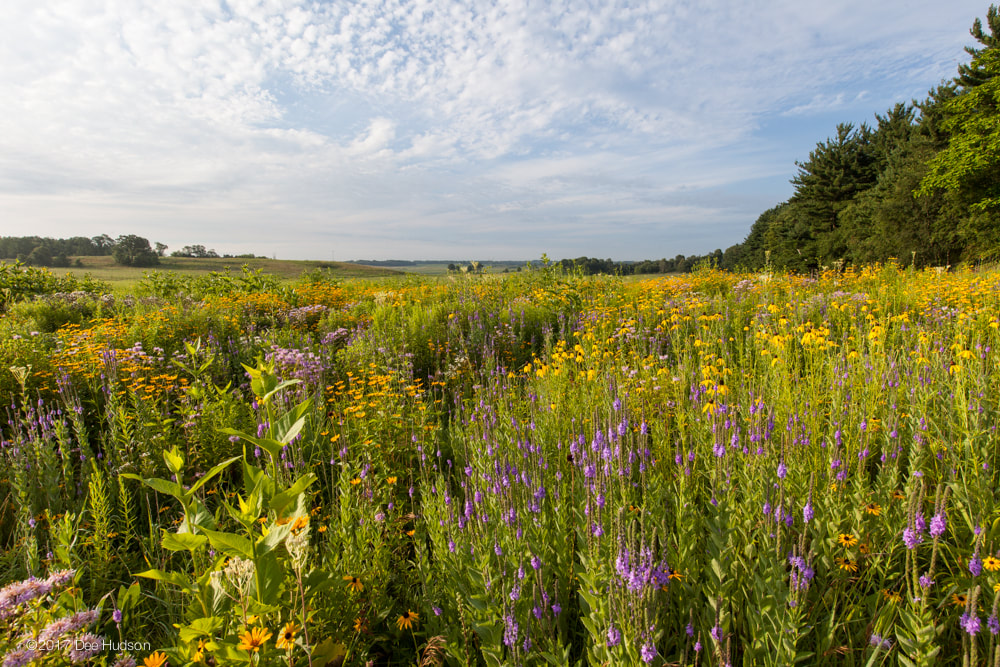|
Autumn has always been my favorite season. Oaks are my favorite trees. So, it seems fitting in "Oaktober" to write about oaks and oak woodlands At Nachusa Grasslands and other places in the Midwest, we are trying to restore the health of our oak woodlands. And really, our region is defined by the oaks. The Nature Conservancy calls our eco-region “The Prairie-Forest Border” between the grand prairie to the south and the mixed woodlands in neighboring states to the north. The area was historically maintained as prairie intermixed with oak savanna and woodlands by Native American nations. Natural plant and animal communities of the region were a direct result of Native Peoples’ use of fire on the land. Without fire, in “The Prairie-Forest Border,” the amount of rain we receive would have yielded dense forests. Many botanists have defined the various intergrades between savanna, open woodland, and closed woodland by the level of sunlight and density and species of trees. (See https://oaksavannas.org/) Today, much of our Illinois woodlands have become too shady to allow sun-loving oaks to grow. Shade is the enemy of oaks. Acorns in shade will not thrive after germination and the limbs of oaks will also die if shaded. How can we tell if the “woods” we are looking at was historically savanna or naturally shady? The presence of large, old oaks with limbs that stick straight out (or used to, but are dead now) indicate the area was likely savanna. An oak growing in full sun without other trees close by will grow limbs horizontally. Oaks that grow close together grow their limbs vertically to reach the sun. To give the oaks a fighting chance modern prairie restorers make use of controlled burns, as well as actual removal of invasive trees growing under and up into the limbs of the old sentinel oaks. We also remove the non-native bush honeysuckle (and other non-native shrubs) from the understory. Our region’s historic mixture of prairie interspersed with woodland types — from dry to wet, from open to somewhat shady — had an enormous species diversity of understory flowers, grasses, and native shrubs. If action is not taken by restorers, the result is a mud forest floor, impenetrable understory with honeysuckle bushes, and an overstory of dead oaks. Elms, maples, and other shade-loving fire intolerant trees move in to take the place of oaks and hickories. This combination of a solid thicket of invasive honeysuckle and loss of oaks gives hardly any habitat for animals. For example, deer and turkey dislike maple and elm, but they love acorns! Native oak-hickory savannas and woodlands in the region are disappearing along with bird species that depend on the open structure: red-headed woodpeckers, great crested flycatchers, and eastern bluebirds. Native wildflowers such as kitten tails, wild hyacinth, prairie lily, and starry campion along with grasses such as bottle brush rye, woodland brome, and long-awned wood grass will not grow in heavy shade. And there are the native shrubs: hazelnut, American plum, hawthorn, and Iowa crabapple! None of these tolerate shade either.
I encourage you to read up on oak woodlands, then take a hike. Explore the Stone Barn Savanna and see how we are doing. It’s a work in progress and sometimes messy, but we see the native oak savanna dependent plants and animals are thriving. Here are some great websites that discuss oak savannas: Pleasant Valley Conservancy—Oak Savannas Last of the Oak Savannas Survive in Minnesota What is an Oak Savanna? Written by Susan Kleiman, a Nachusa volunteer.
8 Comments
Since May, the seasonal crew has been working hard at killing and removing invasive plants from the prairie including white and yellow sweet clover, birdsfoot trefoil, king devil, bouncing bet, and reed canary grass. We started the year walking transects back and forth through the prairie plantings like a militant marching band, carefully spot-spraying each invasive species with a selective herbicide from backpack sprayers. Eventually, the herbicide can no longer kill the targeted plants before they produce seed. Then we switch to hand pulling each plant and carrying them out of the prairie in barrels. This prevents the invasive seed from falling back into the soil, causing problems for future crews. Once the plantings have been swept relatively clean, we slowly drive the trails in small groups, “weed cruising” for the few weeds that were missed during our regular, methodical sweeps. By August, the weed season on the prairie has ended. While it requires painstaking effort to manage hundreds of acres, our methods are working. The invasive populations that once riddled many of our older plantings have been greatly reduced. Seed collecting, an important aspect of restoration, takes place throughout the year. This provides a species-rich, diverse ecosystem. Species diversity encourages a more stable food source for creatures such as insects, bugs, and birds. Last year, the crew’s goal was to plant 103 acres of prairie, Nachusa’s largest planting to date. This year, our goal is to plant 83 acres of diverse habitat ranging from a woodland/savannah border to prairie to more mesic and wetland habitat. However, that doesn’t mean the crew is collecting in small quantities. Thus far we have broken the record for the amount of seed collected in a given year for 17 species! To manage these large, high quality plantings, many days involve a grueling grind of trekking through dense vegetation in the blazing sun and humidity, our socks and pants soaked from the morning dew. For breaks, the crew take refuge at headquarters or in the airconditioned bunkhouse basement. Popsicles, sunflower seeds, and other salty snacks fuel us between meals. This year we were lucky enough to have some dedicated volunteers regularly joining the crew, giving our efforts a huge boost! The expertise of the stewards’ immaculate plantings have fueled our motivation and their expertise exemplifies the knowledge the crew strive to attain. The stewards have been a huge help with plant identification and recommendations of seed species to collect, and they have fantastic seed sources. In return, when the stewards have called for help, the crew has acted as reinforcements in the attack against weeds. The crew also found time to work on side projects which promote better efficiency. We built two 3’ tall, 4’x20’ raised beds for prairie violets and other small species that are hard to collect in large quantities. The hope is that weed management in these beds will be easier than a ground weed mat. It also affords the plants protection from predating ground squirrels. Also, we have begun converting a shed into a seed milling shed, providing future crews more space in which to collect more seed, dry it more quickly, and mill it faster. Phil and Kaleb have returned to NIU as full-time students, and Sandra became a part-timer; therefore we have brought on two new crew members. Daniel Crosby, from Rochelle, has been volunteering with us two days a week since July. Nate Scott, from New York, is experienced in a variety of restoration techniques.
The crew members that have been here longest — Avery, Cody, Nathaniel, and Sandra — will be taking turns as crew leader for the rest of the year. Next time you see one of these energetic young faces, be sure to give them a high five! Written by Kaleb Baker, Nachusa's Crew Boss. |
Blog CoordinatorDee Hudson
I am a nature photographer, a freelance graphic designer, and steward at Nachusa's Thelma Carpenter Prairie. I have taken photos for Nachusa since 2012. EditorJames Higby
I have been a high school French teacher, registered piano technician, and librarian. In retirement I am a volunteer historian at Lee County Historical and Genealogical Society. Categories
All
Archives
January 2024
|
CONNECT WITH US |
|
















 RSS Feed
RSS Feed